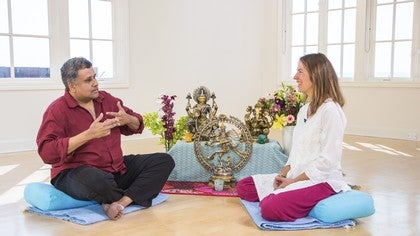Description
About This Video
Transcript
Read Full Transcript
Namaste, dear yogi friend. Namaste, Manoj. Namaste, Julia. So happy to be here today with Manoj Chalam. Manoj is originally from India where he began his life as a scientist. He then came to the U.S. and obtained a degree in... Chemical physics.
Chemical physics from Cornell. He self-confessed on his website, says that he was pursuing a life of fame and fortune and then found that actually his life was going nowhere. And at that point it sounds like he had a very big opening and everything changed and he now has dedicated his life to service and spirituality. And so today he is here as this... He holds an incredible body of knowledge of yoga, Vedanta and Tantra and shares this with many people through storytelling, through entertaining and through the communication of these statues, these deities which are referred to as murtis. You import these from India.
That's right. Yeah. And I've been doing this with my wife for 14 years. Changed my life. And my goal is to change everyone I'm in contact with, change their lives too. So my goal is a Ganesan every home.
So here's an English person and an Indian guy talking about deities, but it's really universal. The energies are universal. They belong to everyone. So I feel in this introduction we're going to give people a taste of what it's all about. Beautiful. And that's very much my intention for today is that often as we come to yoga, we've grown up in a western culture where the Hindu gods and goddesses seem very foreign. It can be a bit of a shock to the system and really to how do we fit in with this?
How does this fit in with us? When we particularly on the path of Bhakti yoga where there's so much about the relationship with these figures in the chanting, in the imagery and all of that. So really the intention today is to just ask and find out like how can these really help us on our path of yoga to awaken and to understand more of our true nature? Great question Nam. I do get it that it is very foreign, you know, but at the same time it's not that foreign also.
And the easiest way to understand these deities is what a famous psychotherapist talked about. Karl Jung, for people who are unfamiliar, Jung was a Swiss psychotherapist and sort of the father of transpersonal psychology. And about a hundred years ago, and for listeners, if you're not used to my accent, you'll be used to it by the time I'm finished. So about a hundred years ago Jung was influenced by these deities and he called them archetypes. He called them archetypes within what he called the collective unconscious.
So for practitioners in the West, the easiest way to understand these deities is they are archetypes within all of us, within the human psyche. In fact, we not only teach to the yoga community, we teach to a large community of Jungian psychotherapists. They actually work with the deities on helping their clients deal with things like trauma, abuse, life transformations, etc. Now, when you know what your archetype is, and I'll explain how, it's like a wave. It just takes you from where you are to where you're supposed to be, be it your personal life, professional or spiritual life.
So many yogis have been doing this for centuries, working with their deity as archetype. And this Sanskrit word for archetype is called ishta devata. So ishta means desired, devata means deity. And I feel it's more bhakti, it's more devotion, it's more heart centered. I feel archetype is a little too intellectual. That's why the bhakti comes in. And then there are specific practices you can do with the deity.
Now let me elaborate on archetypes a little more. So put in a little structure on that. There are archetypes from many traditions, not just the Hindu ones. There are Greek archetypes, Egyptian, Roman. So take, for instance, the Egyptian sun deity, right? We were in Luxor, Egypt many years ago. The sun deity was called Ra, R-A, Amun Ra. And the same sun god in the Roman tradition is Mithra. And the same sun god in the yogic tradition is Mithra or Surya.
So the name Ra is similar even though the archetypes are thousands of years and thousands of miles apart. The reason is they are universal archetypes. They belong to all of us. Now interestingly the Roman god of the sun, Mithra, it's quite fascinating. He was born on around 600 B.C. on December 25. And he was born of a virgin mother. And he was a traveling priest with 12 disciples. He was a traveling preacher in fact. And when he died he got resurrected three days later. Sounds familiar.
So the sun god becomes the sun of god later. The point is these are universal archetypes. However, the yogic ones like Ganesh, Shiva, Lakshmi, etc. have persisted over time. Whereas very few people work with Athena, Isis, Ra, etc. And there's a reason for that. When you truly understand the symbols behind the deities, like for instance why does Ganesh have a mouse, why is there a flame on Shiva, why are the lotuses on Lakshmi, etc. When you truly understand all these deep symbols, they lead you to the formless. They lead you to enlightenment. So that's the missing link which most people don't know. So my mission is to expose people to the knowledge of these deities as symbols to help you wherever you are in your life.
And ultimately if you choose to, and there's a choice, if you choose to lead you to the formless, which is really your true nature. And there's a payoff for that. You can ask the question. So I'm asking the question for you, right? You can ask the question, why do this? Why should one be bothered, right? It really comes down to happiness. If you drill down into the philosophy further, the yogic philosophy, Vedanta, the tradition says you can never reach lasting happiness from something outside you. And that's what I went through, right? You mentioned that. I was on a treadmill to name or fame and nothing really worked.
And when you go down deeper into the formless using the form, the payoff is happiness all the time because you can access it anytime you want. So these are like doorways to accessing the formless within you. Exactly. And I think that's really where it gets confusing for people because it seems perhaps to someone who doesn't really understand that there's this sense of the form being something outside of yourself. Whereas it's really about awakening that which is within you. You got it. It's the archetype within you. And then there are some practices you can do with your archetype to bring that from the collective unconscious all the way to your conscious mind.
So the easiest way to visualize it as one of the beautiful ocean, the Pacific, and there are waves. And we're all like waves in the ocean. Some of us are bigger, some of us are smaller. Underneath the ocean is like the subconscious for all of us. And underneath all that is this vast collective unconscious which is common for all of us. So the waves are like the subconscious. They appear different. But underneath is the same commonality. And that's what Carl Jung called the collective unconscious. And they belong to the whole of humanity. And these deities are buried right there. So they belong to all of us. And when you work with them, you are able to literally suck them from the collective unconscious all the way to your subconscious and conscious. That's where the practice of yoga, the practice of bhakti, that's where it ties in.
So I'm wondering which is your ishta devata? Okay, very good. So minus obviously Ganesh, probably because I have a belly also. So Ganesh is probably the main man in yoga. I have yet to find a yogi who is not connecting with Ganesh. And I'll talk more on Ganesh later, but Ganesh is wildly popular. You find a Ganesh museum in Chiang Mai in Thailand. You find a Ganesh museum in France. You go to Ireland, in Belfast. There's a park with 15-20 foot statues, concrete statues of Ganesh in a park. There's even a Ganesh chugging a Ganesh. So people have adapted Ganesh to their culture. And I feel Ganesh is an archetype for many yogis. He's probably the default archetype.
If you're not sure what the archetype is, it's probably Ganesh because he's the doorway to other archetypes. So he's not only the threshold deity, he's an entrance deity. He removes obstacles in your yogic path, wherever you are. And can your Isha Devata change over time or is there really one that is yourâ?¦ They can change because you change. But usually there's a primary one and then you have secondary one. So like Mayanesh, for instance, Ganesh, Hanuman and Durga. So I'm getting a little geeky now for people who are unfamiliar. But Durga isâ?¦ She's not on this altar but Durga is an amalgamation of all the archetypes. Everyone has given their energies to her. And sometimes they come to you. Sometimes you are drawn to them.
So sometimes they have four hands. So if you have too much stuff going in your life, you wish you have many hands. But more importantly, there are deep meanings in all these different symbols. That's really what we want to focus on. Yeah. And we're going to unpack a little bit of that in the next segment. Exactly. So beautiful. I am really wanting to just hear from you a little bit about some practical tools for working with these archetypes in our lives. So maybe you could just share a little bit about that.
I love that. So the easiest way to start a practice is you create an altar with a deity similar to that. Now there are a total of five practices you can do. And the fifth practice is do nothing. It's a lazy way. In other words, just have the deity in your house. And the word is darshan. Darshan means a gaze. It's like people stand in a temple in India for hours waiting to get a darshan, a viewpoint about deity. Even the six systems of Indian philosophy are called darshanas. Everything is a philosophy, viewpoint.
Now, it's you looking at the deity, but the deity looks at you. When the deity looks at you, it's called kataksham in Sanskrit. And there's a certain energy in that divine gaze. So that's the lazy approach. Okay. Where you gaze at the deity occasionally and the deity gaze at you. And that's enough to shift people. I've noticed this over the years. Now as a scientist, I bring in an element of the science to the sort of vuvu energy stuff, right? So you can actually measure the energy on a deity. And I can talk about that later.
So these deities, when energized, they actually carry energy that can be measured on a scientific basis. That's why when they gaze at you, there's an effect. Okay. Now, the easiest practice a yogi can do is you create an altar. Make it a sacred spot in your home. And just spend a few minutes meditating. Maybe longer, you know. A quiet spot for yourself. And you meditate in front of your deity. So make it a nice altar with candles, flowers, exactly like here. And when people meditate, the impulse is to still the mind. Okay. Stop the thoughts. Right? Restrain the thoughts.
And that's really not what the philosophy of Vedanta is about. Okay. The formless philosophy is you have to sort of go past the obvious. So in other words, your thoughts are not relevant here. What's relevant is the space between your thoughts. Because the gap or the space between your thoughts is pure consciousness. In other words, your thoughts are overlaid on consciousness. So here's where a mantra based meditation can help you. You can choose any mantra. No need to pay a lot of money for a mantra like some organization's church. These mantras are like gravity. They belong to everyone. Okay. And what a mantra based meditation does is drop you in that gap.
And when you meditate and the thoughts decrease, your mind is suffused with pure consciousness because that gap increases. After your meditation, you open your eyes to your archetype or your ishta devata. The mind is like a vacuum. It sucks in all the symbols it represents. And you awaken that archetype within you. So it's a very simple but powerful technique. So what you're doing is imprinting it in your subconscious and your conscious mind. So you're literally drawing it from that deep reservoir of collective unconscious all the way to your conscious mind.
And yogis have been doing this for hundreds of years. So there have been many practitioners and spiritual leaders who have their archetype. Okay. So I'm sort of interested in perhaps how your relationship with Ganesh has helped you in your life, maybe in moments of challenge. Right. I feel Ganesh is, you know, a deity for anything new you would do. For instance, we came here from San Diego. So before the trip, we chanted a mantra to Ganesh. And I personally have a couple of big Ganesh's in my house. Size doesn't matter. It's really what you do with the murti, right? So I did a little prayer to Ganesh.
So anything you knew you would do, a new job, a new drive, anything new, you get his blessings. So Ganesh is very similar to Janus, which is a Greek deity of thresholds. And people used to worship Janus for anything new they would do. And Janus again was a lord of the Annas. And interestingly, Ganesh resides in a root chakra, the muladhara, which is close to the Annas. So very similar. So the practices I would do is not only you would work with Ganesh before you embark on any activity, even when you meditate, you can close your eyes, but I actually open my eyes and chant the Gayatri mantra in front of Ganesh. And that mantra is, you know, when you drill into it a little deeper, The dhi comes from buddhi, which means the intellect.
And the word buddha means his intellect has awakened to the source. That's why buddha means the awakened one. In other words, the closest thing in our mind to the source is our intellect buddhi. So when I chant this mantra in front of Ganesh, this mantra basically says, let the light of all lights. In this case, let the light of consciousness, right? Light in this case is not the light which we commonly think of. It's that in which presence everything is known.
It's the light of knowledge. So let the light of all lights awaken us to our source. In other words, awaken the intellect and may we all become buddhas. So I actually chant this in front of Ganesha or Ganapati, as many people call him. So we all could use a little help. You know, the whole spiritual path is a combination of effort and grace. And grace is where Ganesh comes in. The effort is the meditation, the chantings we do.
Yes. And from my experience there's been some moments where I've been sort of stuck or beginning of something and I'll use that chant and then instantly things will open up. Yes. And I wonder if you have any experiences like that that you could just share one or... Absolutely. I've had so many experiences, okay? It's better I don't talk about myself. Let me talk about a very interesting person I met about seven years ago.
At a yoga conference in Wisconsin and this elderly gentleman walks up to me and he said he wants to buy a Ganesh for his wife who just finished a yoga teacher training, a 200-hour teacher training. So I explained to him all the symbols of Ganesh, like what the mouse means, the sweetie holds, the axe, the noose, why the big belly, why the twisted trunk, etc, etc. And I also explained to him how to practice with Ganesh. So he said all this is fine, but I don't believe you. He said I'm an atheist. Now atheism itself is a belief of no belief, right? But I didn't want to go down that rabbit hole, you know? He's a potential customer, yeah? I said whatever you wish. Now he said I still want to buy that Ganesh for my wife so he bought it. It's a big heavy metal piece about this big. And he carried out to present it to his wife and in five minutes he comes running back holding the Ganesh and he tells me at that very moment he and his wife win a lotto, a drawing for a cruise to the Bahamas. There was a yoga journal cruise and that was worth like several thousand dollars and he's never won anything like that his whole life.
And he was like amazed and the whole day he won't let go of Ganesh. And something triggered in him. So there's a material benefit he got which is the cruise, but the spiritual benefit was he decides to become a yoga teacher. And he goes through the whole training and now he teaches meditation, he buys a big shiva from me. So Ganesh I feel triggers us at many levels. Be it personal, professional or ultimately spiritual. Thank you. Namaste. Thank you so much. Namaste.
The Bhakti Show
Comments
Thank you, Julia & Manoj, for this nourishment.
Much love!
Jai maa!
You need to be a subscriber to post a comment.
Please Log In or Create an Account to start your free trial.













